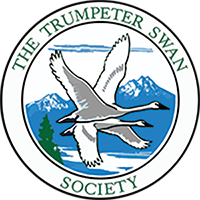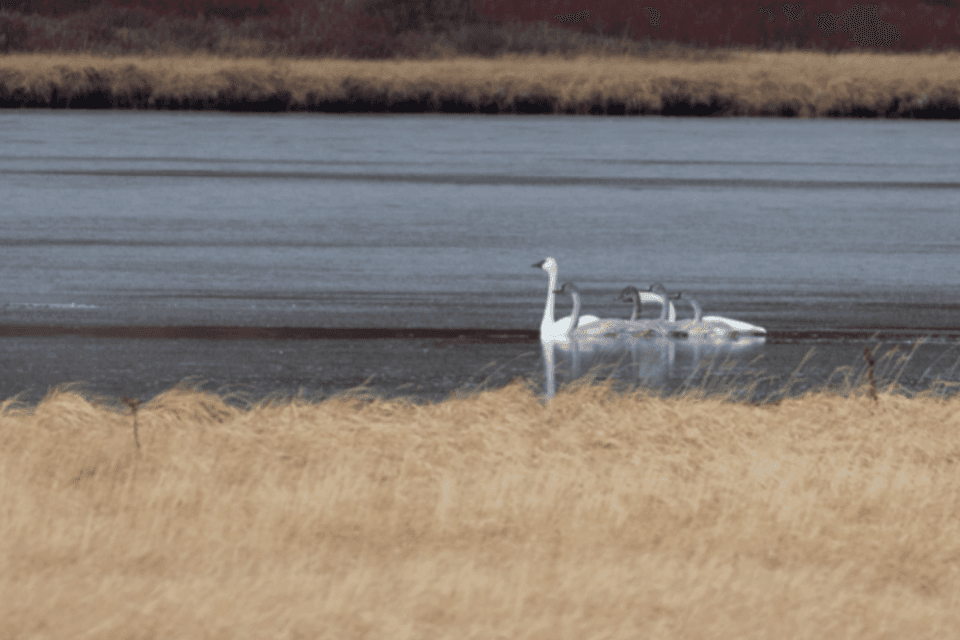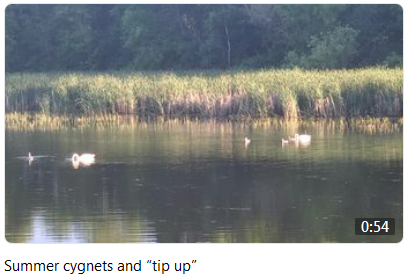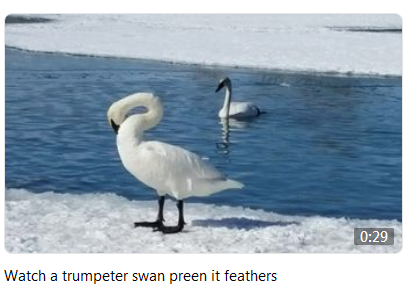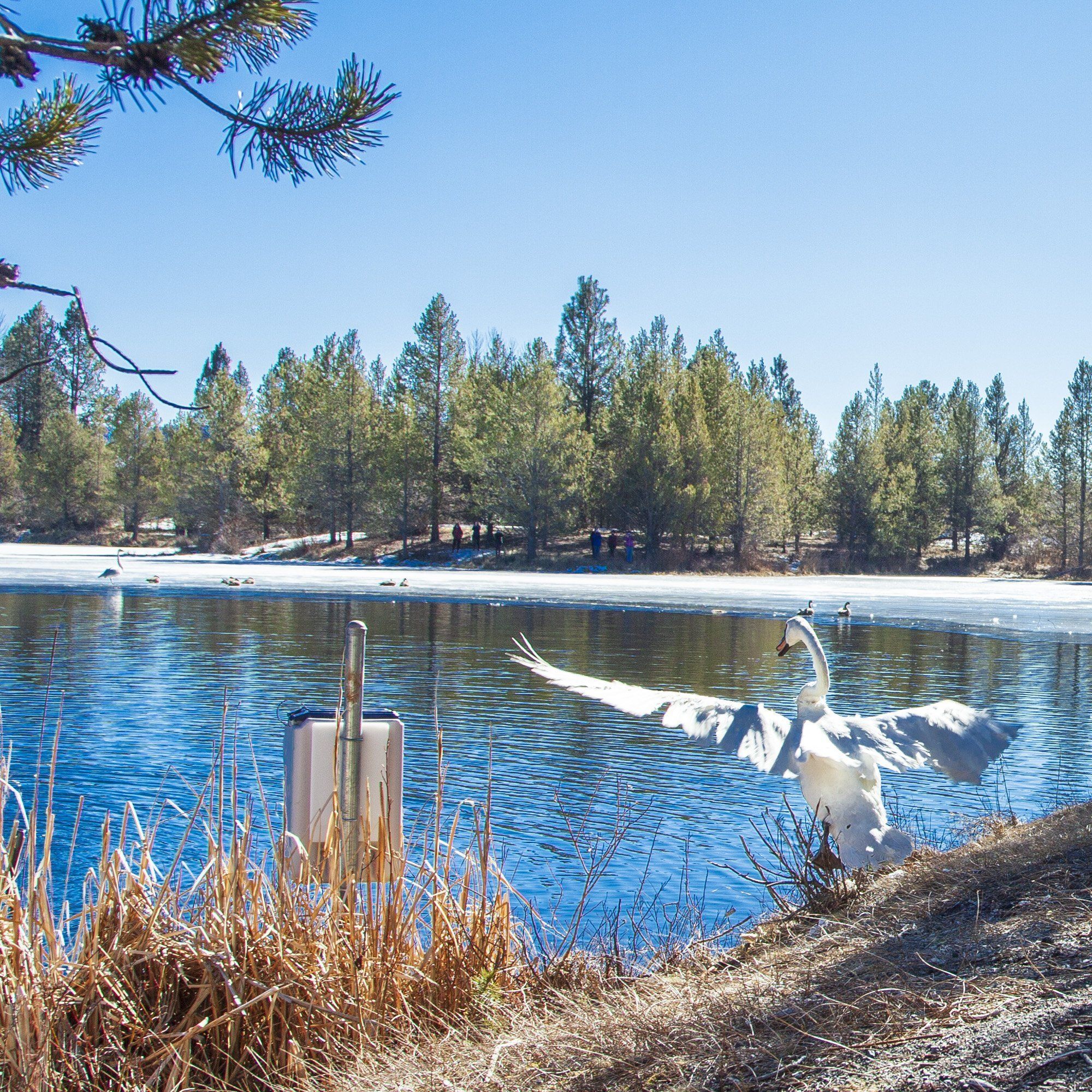Photograph by Margaret Smith
TTSS Blog 2021
IOWA: Iowan has a number of places to see wintering trumpeter swans. If you want to see white this Christmas, snow may be lacking (for now), but trumpeter swans will fill the gap for an outstanding wildlife moment. Read more...
MARYLAND: It’s the time of the year when tundra swans arrive in the Chesapeake Bay from the northern regions of Canada. The swans arrive primarily as family groups, two parents and up to two goslings. This month, more than 100 swans arrived at Blackwater National Wildlife Refuge. Read more...
OKLAHOMA: Trumpeter swans may occasionally be seen in the Skiatook area. We saw a few on a neighbor’s pond in January of 2006. Last week my wife and I were up at the Tallgrass Prairie Preserve, north of Pawhuska, and noted several on a pond just to north of the Visitor’s Center. If they happen to be in our area, they will be here from mid-November through early March. Read more...
IOWA: "For North Country trumpeter swans, the signals were clear. It was time to head south. Southbound flocks varying in size from small family groups to gatherings containing twenty or more were soon dotting the Iowa skies. With only a couple of days remaining in this year’s [North Zone] duck season, it is the swan migration that I will remember the most. By mid-morning, the swans seemed to be everywhere. I later learned that virtually every lake and marsh that still contained bits of open water had attracted at least some of the huge migrants." Read more...
WASHINGTON: Trumpeter swans have returned to local fields in northwest Washington. The lowlands of northwest Washington are again dotted with thousands of photogenic migratory birds. Snow geese, trumpeter swans and tundra swans have returned to Skagit, Snohomish, Island, Whatcom and other Western Washington counties. About 20,000 swans and 80,000 snow geese spend the winter months in the area in Western Washington each year. Most congregate in the Stillaguamish and Skagit valleys from mid-October through early May.
Fish and Wildlife has set up a hotline to report sick, injured or dead swans as part of its ongoing effort to assess the impact of lead poisoning on swans.
People can call 360-466-4345, ext. 266, to report swans that have died or need help. Callers should leave a short message, including their name and phone number, as well as a detailed location of the swan and its condition. The hotline is available through March. Read more...
MINNESOTA: Flight of the trumpeters. With the current cold temperatures in central Minnesota, lakes and streams are beginning to freeze. Swans need to have a place to feed on wild rice in the shallow water. Read more...
UTAH: For the third year in a row, Utah’s swan hunt came to an early close after the trumpeter harvest breached a 20-bird quota set to limit the hunts impact on trumpeters migrating through Utah from the Yellowstone region. On Friday, November 26, the Utah Division of Wildlife Resources recorded the 20th trumpeter death, a threshold that automatically triggering an end to swan hunting for the season. The quota was hit 16 days before the season’s scheduled end of Dec. 12.Utah wildlife officials strongly discourage the killing of trumpeters, but they have yet to outlaw the practice even though some populations are struggling to reestablish their migratory patterns. All Utah swan hunters will likely be required to take a bird-identification course starting next year because too often they are shooting rare trumpeter swans. Read more...
YELLOWSTONE NATIONAL PARK: Trumpeter swans fledge from Swan Lake, first time since 1966. Yellowstone National Park announced today, Nov. 16, that for the first time since 1966, four trumpeter swan cygnets fledged from Swan Lake. The cygnets hatched on Swan Lake about four months ago.
Of the four cygnets that were born on Swan Lake, one took a little longer to develop the ability to fly and was left behind when the lake started to freeze over. Sometimes when a cygnet is not able to fly before freeze-up in autumn, it will die. In this case, the weather warmed up and the lone cygnet was able to forage on their own in the lake. After about a week and a half, the family returned and reunited with the cygnet. The waiting paid off and the fourth cygnet was able to fly to find open water with the rest of the swans, says the park. Read more...
ALASKA: (check out the magnificent photos): "A group of at least 13 trumpeter swans and one tundra swan stopped to feed Sunday evening at Potter Marsh in South Anchorage as they migrate south. Trumpeter swans are found in a wide swath of Interior, Southcentral and Southeast Alaska. Alaska trumpeter swans overwinter from Cordova to the Columbia River. Swans often stop at the marsh in the spring and fall on their migration to and from nesting sites." Read more...
ALBERTA: Trumpeter Swan viewing is one of the highlights for a wonderful autumn experience.
MONTANA: "In an effort to better document the expansion of trumpeter, the Tribal Wildlife Management Program of the Confederated Salish and Kootenai Tribes annually surveys wetlands on the Reservation to record nesting attempts and production. The Tribal Wildlife Management Program staff is requesting observations from the public of trumpeter swan nesting and production of cygnets throughout our area." Read more...
WISCONSIN: This article highlights efforts in Wisconsin to restore trumpeter swans through egg collection in Alaska and partnerships, the 3 year midwest swan tracking study now going on, and the record 10 cygnets hatched in the town of Minong. Read more...
MINNESOTA: Learn more about the tracking collar project of Midwest swans. This fascinating article also includes video and photos.
NORTH DAKOTA: "A third brood of trumpeter swans was found in Grand Forks County. The first of these, reported by Dave Lambeth, the dean of local birders, was the third modern nesting record for the species in Grand Forks County, thus more than doubling the previous known nests." Read more...
VIDEO: Four one-month old trumpeter swan cygnets feed alongside their parents in late afternoon. The trill of red-winged blackbirds is background music in this wetland habitat.
The cygnets are feeding on insects and plant materials near the top of the water. Cygnet necks are growing in length and today they can reach deeper waters than they could just a week before. In this video, as they feed near their parents, the cygnets are beginning to show “tip up”- their tails point straight up for a brief second while their necks reach straight down into the water to reach submerged plants to eat.
Video by Margaret Smith, Executive Director, The Trumpeter Swan Society
VIDEO: A trumpeter swan is standing on ice during the winter. This short video shows it ‘preening’ its feathers.
It is important for swans to keep warm and dry, especially in the winter. Their feathers need to be clean, in good condition and lined up properly all year long for swimming, feeding, flying and nesting. Watch the video and learn more...
MINNESOTA: "To be a baby animal born into a harsh environment full of predators, inclement weather, disease and parasites, is the definition of vulnerability. Indeed, whether that baby animal is an avian nestling of any and all kinds, a white-tailed deer fawn, a baby cottontail rabbit, or frogs and toads having just left their natal ponds after surviving their tadpole transitions, it’s a miracle that any infant creature makes it to adulthood at all.
Once again the resident trumpeter swan pair commenced to courting and nesting on Assawa Lake in early spring. The pair, now a little more experienced, were second nesters, although last year their five cygnets perished one by one." Read what happened this summer...
BRITISH COLUMBIA: TTSS has been working with BC and Washington State folks on this issue for over 20 years. Lead kills!
"A House of Commons petition initiated by an Abbotsford man and adopted by Abbotsford MP Ed Fast is calling for the elimination of lead shot due to its detrimental impact on waterfowl.
The petition was started by Kevin Sinclair, an Abbotsford farmer whose property includes the entire Canadian portion of Judson Lake, home to hundreds of trumpeter swans.
Sinclair says the 100-acre lake is the “primary source responsible for most of the 3,000-plus swan mortalities” over two decades in Canada and the U.S." Read more...
MONTANA: "Earlier this week, Lee Metcalf National Wildlife Refuge Manager Tom Reed spotted six baby swan cygnets swimming on the refuge’s remote ponds. It’s the third year in a row that a pair of trumpeter swans has produced a brood in the Bitterroot Valley...Two years ago, a pair of trumpeter swans produced the first documented wild trumpeter swan cygnets in the Bitterroot since restoration efforts began decades ago to bring the birds back from the brink of extinction in the lower 48 states.
The first year, the swans had two cygnets. Last year, they raised three." Read more...
ONTARIO: "Ah, sweet spring… the flowers are blooming and the birds are singing.
What we perceive to be a peaceful, perhaps even tranquil, scene is actually a war zone. Avian territorial boundaries are constantly being established, challenged, trespassed, defended and realigned. It’s a dynamic world out there!
So why all the fuss? Why not just share the area, build a nest and go about their daily lives? It goes back to the wonderful all-inclusive word called “habitat”. " Read more...
MICHIGAN: "Tens of thousands of trumpeter swans once flourished in the Great Lakes region. But widespread hunting brought the birds to the brink of extinction, and the species was wiped out in Michigan over 100 years ago. A decades-long effort spearheaded by the W.K. Kellogg Bird Sanctuary at Michigan State University has helped bring trumpeter swans back to the Great Lakes — and now, if you’re lucky, you might just catch a glimpse of these protected birds in the wild." Read more...
OREGON: "Eloise, the most prolific trumpeter swan in Oregon’s breeding program, has died of natural causes at her home at the Lake Aspen Golf Course in Sisters.
Golf course staff found Eloise’s body Monday, less than four months after her mate, Pete, died unexpectedly from a bacterial infection.
“I’m personally convinced she died of a broken heart,” said Robin Gold, a wildlife rehabilitation expert who lives in the Aspen Lakes neighborhood and cared for the swan pair.
Eloise and Pete produced 15 young in the past three years. The pair boosted an effort to repopulate the species, which is still recovering from near extinction at the turn of the 20th century." Read more...
NEVADA: Ruby Lake National Wildlife Refuge is both a home and stopover to thousands of migratory birds. "There are many things to do at Ruby Lake National Wildlife Refuge, locally known as the “Ruby Marshes.” Birding sits at the top of the list for some. There are at least 225 species. ..The refuge is considered the most remote national wildlife refuge in the contiguous states...Depending on the time of year, we could have both trumpeter and tundra swans on the refuge,” said Ruby Lake wildlife biologist Jane Bardolf. “During the breeding season, we just have a few trumpeter swans.” Read more...
MONTANA: "In the early 1990s, the CSKT, U.S. Fish & Wildlife Service, and Montana FWP began discussing how to return trumpeter swans to western Montana after the bird’s century-long absence. Beginning 1996, Becker led the re-introduction of trumpeter twans on the Flathead Reservation and in north western Montana...t was important to the Tribes’ two Elder committees that we replace this important missing piece of the region’s bio-fauna.”
“When you look up, and see trumpeter swans passing over, that’s Dale,” McDonald said. “They are a part of his legacy.” Read more...
ALBERTA: "Known for their shyness, it's not easy to get a good glimpse of the largest migratory bird in North America. But that means that when it happens, it's all the more impactful. Naturalist Brian Keating said over the last couple of years, he has seen trumpeter swans in the city of Calgary flying up and down the Bow River. When it happens, he said it fills his heart with joy...In Keating's view, the increased presence of the trumpeter swan in the province is one of the real success stories in Alberta's backyard." Read more...
OREGON: "The new female trumpeter swan at the Sunriver Nature Center has been named Valentina, or Val for short, since she was brought to the center just before Valentine’s Day. The nature center received several name suggestions after the swan was introduced Feb. 10 to Gus, the resident trumpeter swan who was alone since last fall when his mate, Gracie, was found dead from a likely coyote attack." Read more...
ALASKA: This article has great information about Trumpeter Swan facts. Check it out! "On the nesting grounds, they choose freshwater marshes, ponds, and small rivers, building nests on beaver dams and lodges, hummocks, and platforms of floating vegetation. The nests are typically surrounded by water, giving them room for a running take-off when departing. Both male and female work on nest-building, both birds collecting material but the female doing most of the construction. The big eggs are laid at intervals of one and a half to two days (not daily, as in most birds). Both members of the pair incubate the clutch of (usually) four to six eggs, but neither develops an incubation patch on the body…they incubate the eggs with their huge, well-vascularized feet! " Read more...
NEW YORK: "Well, it finally arrived. Spring! How do I know? The geese and swans told me...This year the swans really put on a show for wildlife lovers. More swans showed up than ever before (I’d estimate about 200 at first) and they parked themselves right in this small marsh for the whole world to see. They began to arrive on March 9th and only recently began to moving north about March 17th." Read more...
MONTANA: "his last weekend was a good one for birdwatchers at Freezout Lake west of Great Falls. Some folks from Hamilton were there and experienced the spectacle of an estimated 25,500 Snow Geese and Ross's Geese, along with about 2,400 migrating Tundras and Trumpeter Swans in their annual spring stopover at the ponds of the Freezout Lake Wildlife Management Area...Because of it's location along the Rocky Mountain Front, on a main flyway, Freezout usually has visits from over 230 species of birds throughout the year, but the days of the migrating geese and swans are memorable...Because of its location along the Rocky Mountain Front, on a main flyway, Freezeout usually has visits from over 230 species of birds throughout the year , but the days of migrating geese and swans are memorable." Read more...
MICHIGAN: Upper Peninsula. "As has been mentioned before in this column, the trumpeter swan is an endangered species success story, going from the edge of extinction in the 1930s to an estimated 63,000 in 2015. Yet they still face risks, from fatally ingesting lead shot while feeding to colliding with power lines to having “the lowest genetic diversity of any waterfowl species that has been studied,” according to the non-profit Trumpeter Swan Society, www.trumpeterswansociety.org." Read more...
OHIO: After years of dedicated conservation work by the Ohio Department of Natural Resources (ODNR) Division of Wildlife and its partners, trumpeter swans once again nest in the Buckeye State.
This work is made possible, in part, by Ohio’s annual tax donation program. This is an important way for wildlife enthusiasts to help contribute to restoring and managing endangered and threatened wildlife, including trumpeter swans. Funds from the income tax donation program go directly to projects that protect Ohio’s wildlife and natural areas. By making a tax donation to the Wildlife Diversity Fund on this year’s tax form, Ohioans are helping to ensure the future of Ohio’s ecosystems, supporting research on trumpeter swans, monarch butterflies, lake sturgeon, hellbenders, and more. Read more...
MINNESOTA: The small bits of fishing tackle lead, which have been building up on lake bottoms for decades, are poisoning and killing trumpeter swans, loons, bald eagles and other wildlife.
Swans and loons are especially vulnerable to lead poisoning from tackle, diving to the bottoms of lakes to scoop up small slip shots and other sinkers as if they were gravel to grind up and help digest their food.
"If they accidentally swallow even one lead slip shot or jig, they die," said Carrol Henderson, who headed the Minnesota Department of Natural Resource's Nongame Wildlife Program for more than 40 years until his retirement in 2018.
A lead ban is long overdue, he said.
Rep. Peter Fischer, DFL-Maplewood, introduced the proposed ban this week to a House environmental committee. It would prohibit the production and manufacture of small lead jigs and sinkers in Minnesota by July 2024, and outlaw the use of any lead tackle that weighs an ounce or less by anglers starting in 2025." Read more...
OREGON: With a crowd of onlookers on hand, a new adult female trumpeter swan was released onto Lake Aspen in Sunriver Wednesday afternoon, a special pre-Valentine's Day arrival and gift of sorts for another swan who recently lost his mate.
The new swan is intended to be a mate for Gus, the resident male swan whose previous mate, Grace, died in October. The pair of swans is cared for year-round by Sunriver Nature Center & Observatory and is a part of Oregon’s Trumpeter Swan Restoration Program. Read more...
MINNESOTA: Two state lawmakers from Maplewood, with the strong support of north metro watershed districts, have again introduced legislation to remove toxic lead from fishing tackle...Two Maplewood DFLers, Sen. Charles Wiger and Rep. Peter Fischer, introduced bills in January to ban the sale and use of lead fishing jigs and sinkers...According to one estimate, as many as 25% of loon deaths nationally are caused by lead poisoning, Amoth said. While finding a large dead swan in a popular suburban park is sad and memorable, it's just a small example of the death toll. Read more...
MISSOURI: "Trumpeter swans, once nearly extinct in the lower 48, now winter at the confluence by the thousands. The continent's biggest native waterfowl has been flocking to Riverlands Migratory Bird Sanctuary—and winning a fanbase." Read more...
OREGON: "The most prolific trumpeter swan pair in Oregon’s breeding program experienced a tragic turn of events Saturday when the male, Pete, died from a bacterial infection. Pete and his mate, Eloise, produced 15 young at Sisters golf course that were released into the Oregon wild." Read more
